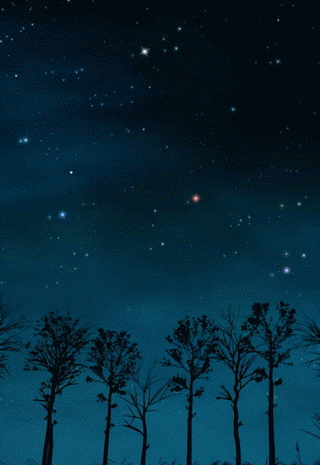Falling stars have traditionally had a myriad of metaphysical and spiritual meanings behind them. Stars are, in particular, frequently associated with the idea of the human soul. In the Teutonic mythology of central Europe, it was believed that every person was represented by a star which was attached to the ceiling of the sky by the threads of fate. And when Fate ended your story on earth, she would snip the thread attaching your star and it would fall, presaging your death.
In Romania, there is a belief that the stars are candles lit by the gods (and later the saints) in honor of each person’s birth and that the brighter the star the greater the person. The falling star represents the soul’s final journey to the afterlife as it is being blown out and across the sky by the divine candle keepers. In these and other cultures, falling stars and meteor showers were celebrated ~ they honored the ancestors who had come before them, and in particular the newly deceased who were joining the ranks of the highly venerated generations who had come before.
Even in the Middle Ages after the triumph of Christianity, the pagan equation between shooting stars and the movement of souls could not be snuffed out entirely. And so it was vilified; the shooting stars were cast as the souls of evil and impious men being cast out of heaven and down into the bowels of the earth.
Shooting stars in particular hold a special place with the cosmic mythologies of most ancient civilizations. For the falling star represents an interaction between man and the divine. It represents something moving from a heavenly cosmic plain to the mortal, earthly world. It was probably with some surprise that upon tracking the falling place of a “star” to earth, they would discover a small crater filled with a glassy rock, which, today of course, we call a meteorite.
Many cultures venerated meteor rocks as powerful magickal talisman, sent from the sky gods to the denizens of earth. The ancient Greeks believed that finding one would bring you a year’s worth of good luck and a wish; and it is from them that we have ultimately inherited the idea of wishing upon a star. Native American medicine men have been known to wear them as protective amulets, passing them down through generation after generation of shaman as symbols of their power. And temples throughout the ancient Mediterranean were in possession of meteorites, likewise holding them as sacred objects.
Even in the modern world, a meteorite is one of the most venerated objects in contemporary monotheistic religious practices: the Black Stone of the Ka’baa. Believed to have been sent from God to Abraham and then passed down to Mohammad, the Ka’baa stone is technically a relic of all three Abrahamic faiths (Judaism, Christianity, and Islam), and is the centerpiece of the holiest of holy Mosques in Mecca in modern Saudi Arabia, a former temple to the local Moon/Water God.
In the modern world we explore the stars scientifically: searching for the answers to the Big Questions regarding the origins of life and the extent of the wider universe around us. We look up at the stars through veils of ambient electric lights and smog, wishing upon them still. We escape to the countryside to truly see the stars as best we may, watching them in place of the television sets which usually fill our nightly vision.
For much of the time mankind has walked the earth, we did not know the stars as we know them to be today: huge balls of plasma energy strung out in space billions of light years away. Instead, we held them on high as something else, something magickal. In ancient societies, when the sun went down, there was the vast illuminated landscape of a starry sky lurking above them: mysterious and constant. It was a distinct part of their cultural worldview; its placement in the heavens and its occasional idiosyncrasies explained as part of ancient mythologies and religions. Imagine their wonder looking up at the night sky and imagining it looking right back at them.
And bear in mind, that without electric lights to dim the view, the night sky would have been distinctly brighter and filled with finer textures and gradients of colors and lights. The Milky Way not a slightly filmier band across the sky but a broad avenue of swirling colors stretching across an upside down starscape: a fitting pathway for the gods or divine river among the cosmos.
Shooting stars have and always will hold a special amazement to those viewing them. For their beauty alone they are worth staying up for.
From: Ray Violet and Within the Sacred Mists,
2 Responses to Falling Stars
Leave a Reply to Joey Axle Cancel reply
- Bean Magick and Lore by shirleytwofeathers - 6 Comments
- Purple Loosestrife Magick and Lore by shirleytwofeathers - 5 Comments
- Onion Magick and Lore by shirleytwofeathers - 4 Comments
- Magickal Uses of Mud Dauber Dirt by shirleytwofeathers - 4 Comments
- Herbs by Gender by shirleytwofeathers - 4 Comments
Michaela Renee Solomon: Bean Magick and Lore
Alex Jinn: Holy Water
Lilith Linlithgow: AZaJ2zpS1xg
Tina from Magickal Spot: Ingwaz Rune Magick
Tina from Magickal Spot: Thurisaz Rune Magick




This is really great. May I get permission to use the gif in one of my music videos?
I don’t own the rights to the gif… sorry. If I did, I’d be happy to say yes.